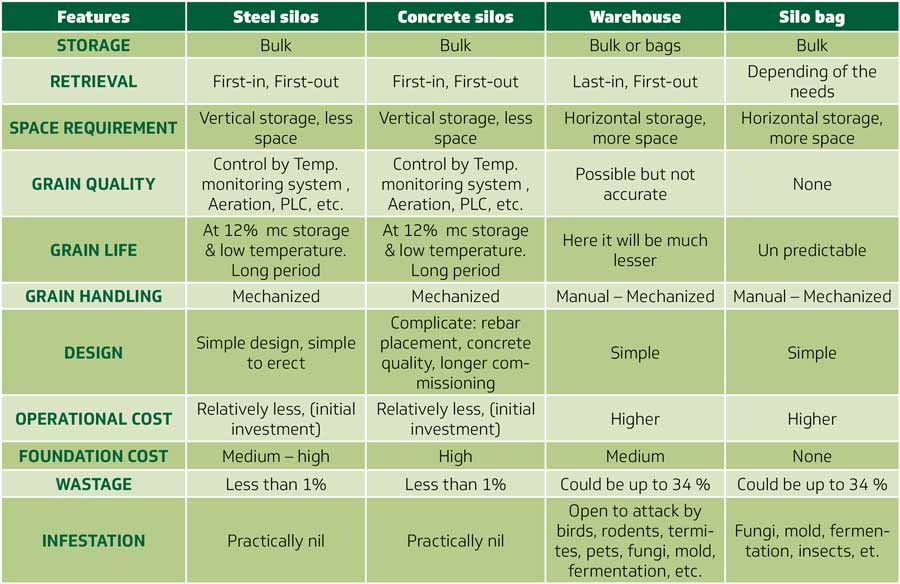Rice is one of the most important human food crops in the world, directly feeding nearly half of world’s population. Adequately performed rice post-harvest handling operations contribute to prevent food losses and consequently to achieve food security.
The key to correct rice storage is to keep the grain clean, dry, healthy and without mechanical damage. Therefore, proper management of technology is crucial.
FACTORS AFFECTING THE RICE STORAGE
Moisture content. Rice is usually harvested with a moisture content of ≈ 25%
Temperature. Growth of fungi and chemical changes such as oxidation are increased with temperature. Moreover, it is really important to consider the climate in the different regions of the world.
Storage period. The shorter the better. Cleaning the grain prior to storage will minimize the risk of spoilage and economic loss.
General condition of the rice and the amount of foreign materials. Broken seed during harvesting, surface and internal conditions, impurities in bulk paddy, etc.
POST-HARVEST HANDLING OF RICE AND ITS EFFECTS ON QUALITY
The processes involved in the post-harvest handling of rice are reception, cleaning, drying and storage. If all these processes are adequately performed, we will be able to maintain the highest quality.
RECEPTION PROCESS
Moisture content and heat are decisive factors in grain storage. They will condition the grain quality and, therefore, the final product quality.
In this initial step, we should consider:
Analyzing the rice upon arrival to the storage plant. Take samples for measuring the heat and moisture content and the percentage of foreign particles.
Insect control measures or mold activity. Currently there are high technological equipment able to do so without a high investment.
Aspiration system. It is highly recommendable to eliminate fines particles coming with paddy and allow a good ventilation during the storage period.
CLEANING PROCESS
Cleaning is the process of removing foreign particles from the bulk.
An integrated cleaning system adapted to the grain’s needs should be installed.
Equipment necessary for the cleaning process:
Magnet separator. It is appropriate to get metal out from grains. This device will avoid damage or failures in the following processes.
Drum sieve. It separates coarse impurities such as pieces of straw, paper, pieces of wood… This device will avoid damage or failures in the following processes.
Grain precleaner. It removes dust and light particles from grain.
Grain cleaner. It includes a screen for incoming gross material such as sticks, leaves, straw, etc.
Buffer silos. They are installed after the cleaning process, because usually, the drying capacity of the storage plant is lower than cleaning system capacity. This way, paddy will be stored in the buffer silos while waiting to be dried.
- Ventilation system: Doing this kind of ventilation we can prevent or reduce also the “uniform drying”.
- Exhaust fans: To prevent condensation.
- Over-head cone: This system allow a FIFO flow system, guaranteeing that all grain will be able remain inside the silo the same period.
DRYING PROCESS
Drying is the process that reduces grain moisture content to a safe level for storage.
Important problems that will reduce the rice quality:
- Discoloration/Yellowing is a result of heating in the paddy grain before drying.
- Loss of germination: High respiration level will lead to reduction of grain viability for germination.
- Loss of freshness/odor development: changes in chemical components like fatty acids, sugar reduction, kernel hardness, etc.
- Breakage of the kernels.
- Field drying or stacking.
- Sun drying.
The dryer election will depend of your technical requirements, but here are some general recommendations:
- Clean before dry, since impurities in grain bulk reduce the air flow.
- Do not mix wet and dry paddy.
- Take samples to control the moisture content and temperature during the drying process.
- Experience in previous drying will lead to increased drying efficiency.
- Dry a maximum of 5% of the moisture content at a time and then leave the rice to rest for a minimum of 8 – 12 hours.
Tempering silos
Tempering silos are used to cold down the grain and make the bulk grain uniform in terms of temperature and MC.
Depending on the storage capacity, we can cool down the grain either using a tempering silo or in the final storage system.
STORAGE PROCESS
Whilst the choice of grain storage methods is wide, the most popular ones are steel silos, concrete silos, storage warehouses and bag silos among others.
Features of Main Storage Processes

Galvanised sheet metal silos are nowadays the best alternative for grain storage thanks to their versatility, easy assembly, hygienic handling and low storage cost.
At this point paddy is already clean and dry and we just need to manage the storage process properly to keep the maximum quality.
Recommendations:
- Ventilation system including ventilation channels, ventilation grills, exhaust fans, centrifugal fans/chillers.
- Temperature monitoring system.
- Sweep augers for discharging flat bottom silos.
- Handling equipment that can transport grains without damage, such as belt conveyors.



